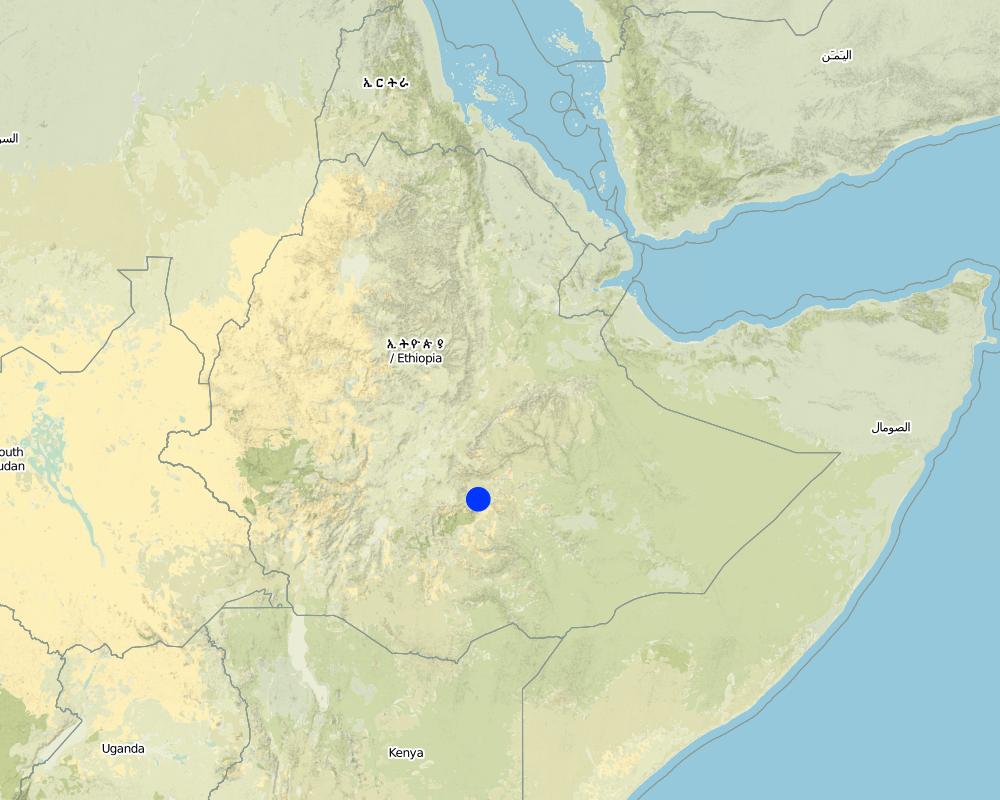Local Level participatory planning approach (LLPPA) [เอธิโอเปีย]
- ผู้สร้างสรรค์:
- การอัพเดท:
- ผู้รวบรวม: Philippe Zahner
- ผู้เรียบเรียง: –
- ผู้ตรวจสอบ: Fabian Ottiger
approaches_2675 - เอธิโอเปีย
ดูส่วนย่อย
ขยายทั้งหมด ย่อทั้งหมด1. ข้อมูลทั่วไป
1.2 รายละเอียดที่ติดต่อได้ของผู้รวบรวมและองค์กรที่เกี่ยวข้องในการประเมินและการจัดเตรียมทำเอกสารของแนวทาง
ชื่อของโครงการซึ่งอำนวยความสะดวกในการทำเอกสารหรือการประเมินแนวทาง (ถ้าเกี่ยวข้อง)
Swiss Agency for Development and Cooperation (DEZA / COSUDE / DDC / SDC) - สวิตเซอร์แลนด์1.3 เงื่อนไขที่เกี่ยวข้องกับการใช้ข้อมูลที่ได้บันทึกไว้ผ่านทาง WOCAT
ผู้รวบรวมและวิทยากรหลักยอมรับเงื่อนไขเกี่ยวกับการใช้ข้อมูลที่ถูกบันทึกผ่านทาง WOCAT:
ใช่
1.4 การอ้างอิงถึงแบบสอบถามเรื่องเทคโนโลยี SLM

Stablized Stone Faced Soil Bund [เอธิโอเปีย]
Stablized bund constructed fron stone and soils on the farm land along the contour and planted with multipurposive plant species
- ผู้รวบรวม: Unknown User
2. คำอธิบายของแนวทาง SLM
2.1 การอธิบายแบบสั้น ๆ ของแนวทาง
Participatory planning tools using various PRA techniques to enable the local community to identif their problem prioritize to sellect suitable measures & activities (planing, implementing & mgt of conservation based initiatives.
2.2 การอธิบายอย่างละเอียดของแนวทาง
การอธิบายอย่างละเอียดของแนวทาง:
Aims / objectives: Aims at the sellection of suitable measures & activities in line with the problems needs of the community & individuals relating to soil & water conservation, To develop (enable) the community to involve (participate) fully inplaning, implementing, monitoring managing of conservation based initiatives and decision making, Aims at the selection of suitable measures and activities in line with the problem and needs of the community and individuals, Hence promotion of productivity of the project areas to address the problems, Employ a wide range of methods facilitate community participation in planning discustion on subject area (suitation), i.e. general discustion with community, Group and indvidual discussion community meeting, consulting., Identify targeted areas, initial meeting with community leaders, adminstrators 1st meeting with community. Form (sellect) development team., Problem identification prioritize sellect suitable measures & activities work plan pre paration, planning implementing, monitoring evaluation., Identify the major problems, prioritize identification sellection of proposed development, measures. Work plan preparation, Implementation of sellected activities.
2.5 ประเทศ ภูมิภาค หรือสถานที่ตั้งที่ได้นำแนวทางไปใช้
ประเทศ:
เอธิโอเปีย
ภูมิภาค/รัฐ/จังหวัด: :
Oromiya
Map
×2.6 วันที่เริ่มต้นและสิ้นสุดของแนวทาง
ระบุปีที่เริ่ม:
1992
2.7 ประเภทของแนวทาง
- ใช้โครงงานหรือแผนงานเป็นฐาน
2.8 เป้าหมายหรือวัตถุประสงค์หลักของแนวทาง
The Approach focused mainly on SLM with other activities (Micro credit schems, forest development, water development, development of infrastructure.)
The SLM Approach addressed the following problems: Erosion problem (Soil and Water), Food shortage problem, Infrastructure problems, Production problems.
2.9 เงื่อนไขที่เอื้ออำนวยหรือเป็นอุปสรรคต่อการนำเทคโนโลยีภายใต้แนวทางนี้ไปปฏิบัติใช้
บรรทัดฐานและค่านิยมทางสังคม วัฒนธรรม ศาสนา
- เป็นอุปสรรค
Need external inputs, Lack of responsibility to keep & maintain
Treatment through the SLM Approach: Provide training, encourage the participation of community in all activities.
การมีไว้ให้หรือการเข้าถึงแหล่งการเงินและบริการ
- เป็นอุปสรรค
Poverity; less production yield, shortage of farmland, increasing of family size
Treatment through the SLM Approach: Apply income generating projects, intensfy family planning programme, improve local farming system, effective management.
การจัดตั้งระดับองค์กร
- เป็นอุปสรรค
Less finanical capacity & skilled man power, lack of well & highly organized institue
Treatment through the SLM Approach: Encourage the involvement of different NGO's strengthen their capacity.
ความรู้เกี่ยวกับ SLM การเข้าถึงการสนับสนุนด้านเทคนิค
- เป็นอุปสรรค
Lack of skilled manpower, ignoring of indigenous k/dge; less technical awareness of farmers.
Treatment through the SLM Approach: Capacity building, community training, encourage (modify) indigenous k/dge.
3. การมีส่วนร่วมและบทบาทของผู้มีส่วนได้ส่วนเสียที่เกี่ยวข้อง
3.1 ผู้มีส่วนได้ส่วนเสียที่เกี่ยวข้องในแนวทางนี้และบทบาท
- ผู้ใช้ที่ดินระดับท้องถิ่นหรือชุมชนระดับท้องถิ่น
Specific ethnic groups: Locally existing groups
Because of the local cultural norms cultural barriers. Mainly men be a team leader, and excutives. Group 1 & group 2 By ranking their wealth & using vulnearability ranking & the sellected criteria of land size & live stock holding.
- รัฐบาลแห่งชาติ (ผู้วางแผน ผู้ทำการตัดสินใจ)
Regional state, W/resource dev. Authority MOA.
- องค์การระหว่างประเทศ
3.2 การเกี่ยวข้องของผู้ใช้ที่ดินระดับท้องถิ่นหรือชุมชนระดับท้องถิ่นในช่วงต่างๆของแนวทาง
| ความเกี่ยวข้องของผู้ใช้ที่ดินระดับท้องถิ่นหรือชุมชนระดับท้องถิ่น | ระบุผู้ที่มีส่วนเกี่ยวข้องและอธิบายกิจกรรม | |
|---|---|---|
| การริเริ่มหรือการจูงใจ | ไม่ลงมือ | consuling; Participate by consulting involved by answering question area. |
| การวางแผน | ปฏิสัมพันธ์ | Mainly: rapid/participatory rural appraisal, public meetings; partly: workshops/seminars, interviews/questionnaires; Planning prepared by Devt. Team descussed with communities. |
| การดำเนินการ | จ่ายเงินหรือสนับสนุนจากภายนอก | casual labour, responsibility for minor steps; Participatte by his labour & contribute equipment (materials) |
| การติดตามตรวจสอบหรือการประเมินผล | ไม่ลงมือ | Mainly: interviews/questionnaires, public meetings; partly: measurements/observations; Involved by answering questions |
| Research | ไม่มี |
3.4 การตัดสินใจเลือกใช้เทคโนโลยี SLM
ระบุผู้ที่ทำการตัดสินใจเลือกเทคโนโลยีมากกว่าหนึ่งวิธีไปปฏิบัติใช้:
- ผู้ใช้ที่ดินเป็นผู้ตัดสินใจหลัก โดยการสนับสนุนจากผู้เชี่ยวชาญ SLM
การอธิบาย:
Land users sellect the suitable measures of activities facilitated by SWC specialists.
Decisions on the method of implementing the SLM Technology were made by mainly by SLM specialists with consultation of land users
5. การสนับสนุนด้านการเงินและวัสดุอุปกรณ์
5.1 ระบุงบประมาณประจำปีสำหรับแนวทาง SLM นี้
แสดงความคิดเห็น (แหล่งของการระดมทุน ผู้บริจาคคนสำคัญ):
Approach costs were met by the following donors: international non-government (-): 100.0%
7. การอ้างอิงและการเชื่อมต่อ
7.1 วิธีการหรือแหล่งข้อมูล
- ไปเยี่ยมชมภาคสนาม การสำรวจพื้นที่ภาคสนาม
- การสัมภาษณ์กับผู้ใช้ที่ดิน
ลิงก์และโมดูล
ขยายทั้งหมด ย่อทั้งหมดลิงก์

Stablized Stone Faced Soil Bund [เอธิโอเปีย]
Stablized bund constructed fron stone and soils on the farm land along the contour and planted with multipurposive plant species
- ผู้รวบรวม: Unknown User
โมดูล
ไม่มีโมดูล


